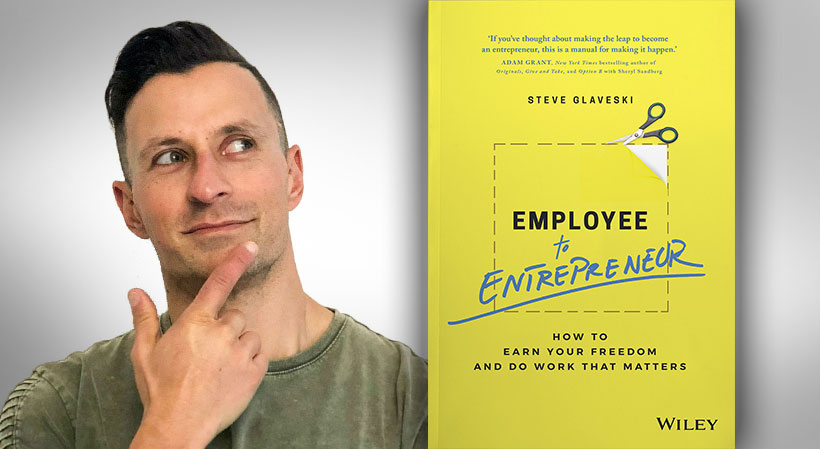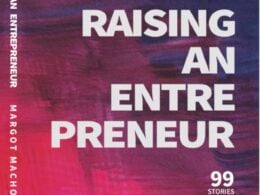The following is excerpted from “Employee to Entrepreneur: How to Earn Your Freedom and Do Work That Matters” by Steve Glaveski.
In the past 10 years, I’ve worked across the public sector, at a big four consulting firm, at an investment bank, and founded a web startup. I completed a master’s degree in accounting, got a certificate in journalism, earned project management and agile certifications, and completed a number of online courses on topics such as venture capital, design thinking, growth hacking, and even stand-up comedy. I founded and ran a heavy metal nightclub, a corporate innovation consultancy and a children’s entrepreneurship program. I published three books, hosted two podcasts and developed a software platform.
I rode a motorcycle, tried my hand at mixed martial arts, Brazilian jiujitsu, boxing and, in Thailand, Muay Thai. I learned how to surf in Bali (poorly). I played guitar in an 80’s glam metal tribute band, zebra-print pants and all — good luck finding the photos! I jumped out of a plane at 15,000 ft., white water rafted in Indonesia, learned how to skateboard, took a Circus Trapeze class and gave Acroyoga a shot, braved the standup comedy stage, competed in a half marathon and a sprint triathlon and finished in the top 5 percent of a Spartan Race in Melbourne.
I went to two World Cups (Germany in 2006 and Brazil in 2014 – I won’t share which I thought was better so as not to offend my Brazilian friends) and to music festivals around the world including Germany’s iconic Wacken Open Air, partied in Spain’s Ibiza, explored different types of music from Beethoven and Johnny Cash to The Prodigy and Finland’s Ensiferum, tried (with middling success) to learn Mandarin and Portuguese (my Portuguese was not ‘muito bom’!), and visited favelas in Brazil, slums in India and rural villages in Vietnam. I learned how to make seriously good espresso, read and listened to hundreds of books and thousands of podcasts and met all kinds of people at functions and conferences across the globe.
This audit barely scratches the surface of a decade of my life, but it does represent many dots that I’d later learn to connect, consciously or intuitively. As former World Series of Poker champion Annie Duke puts it, “Your intuition is developed through past experiences, and so in order to develop a better intuition and make better decisions, you’ve got to learn from diverse sources.”
Steve Blank, widely considered the “Godfather of Silicon Valley” and the lean startup movement, believes people who are on top of their game are always curious about a lot of things—it’s in their brain chemistry. When I spoke to Steve on my podcast he told me, “We talk about resilience, we talk about agility, we talk about all the tactical things that make entrepreneurs go through walls, but I think the thing that makes them great and different is they’re curious about more than just what you would think was their domain. They’re perpetually curious — it doesn’t stop.”
6 Steps to Choosing a Business: Follow Your Passion, Measure Your Risk
Collect the dots before you connect the dots
Too many people tell me they’re unsure what their passion or purpose is. This isn’t because they don’t have one. They just haven’t found it. Or, more to the point, they haven’t been trained to see it.
This usually means they pursue business ideas purely for monetary gain or for the freedom of being their own boss. They’ll stay the course begrudgingly, without truly believing in their work, because of the sunk cost investment they’ve already made, and come Friday morning it’s “TGIF,” while Sunday nights are spent dreading the following morning. That’s no way to live. Yet for so many, it’s become an accepted and unchallenged norm. These days I say TGIM and still enjoy my weekends.
How do you train yourself to find your purpose and passion? You collect and connect dots.
Steve Jobs on connecting the dots
At his famous Stanford commencement speech, Steve Jobs explained that “You can’t connect the dots looking forward; you can only connect them looking backwards. So, you have to trust that the dots will somehow connect in your future. You have to trust in something — your gut, destiny, life, karma, whatever. This approach has never let me down, and it has made all the difference in my life.”
What Jobs was talking about was broad experiences, in both a professional and a personal context, which often intertwine. In Jobs’ case, his early interest in Zen Buddhism has been credited with influencing the simple minimalism of the Apple Mac and subsequent Apple products. Sitting in on calligraphy classes at Stanford (for which he wasn’t enrolled) encouraged a love of typography that found expression in Apple typefaces. And who can forget his now infamous tour of Xerox’s Palo Alto Research Centre (PARC), where he stumbled on a “graphical user interface” that Xerox had little idea how to commercialize, so he “borrowed” it for Apple. This was 1979, when all human-to-computer interaction was still performed through command line interfaces.
Steve Jobs collected and connected a lot of dots on his road to creative and financial success.
Most successful entrepreneurs solve problems they connect with personally because they’ve observed them (collected the dots) and shortlisted potential solutions based on their research and understanding of business model and technology innovations (connected the dots).
Think of:
- Uber: On a snowy Paris evening in 2008, Uber co-founders Travis Kalanick and Garrett Camp couldn’t find a cab, so they came up with the concept for Uber: push a button, get a ride.
- Airbnb: Co-founders Brian Chesky and Joe Gebbia decided to rent out air mattresses in their apartment to attendees of a Silicon Valley conference because all the hotels were booked out.
- Dropbox: Drew Houston, Dropbox’s founder, established the cloud storage company “out of personal frustration.” He recalls “carrying a thumb drive around and emailing myself files and all the things that we used to have to do.”
Often entrepreneurs connect the dots between seemingly disparate areas
Turning Your Passion into Profit: Side Hustles for the Digital Nomad
Connecting the dots with first principles thinking
Entrepreneurs such as Elon Musk, Jeff Bezos, Peter Thiel and Nobel Prize-winning physicist Richard Feynman credit much of their success to first principles thinking.
Musk says, “First principles is kind of a physics way of looking at the world. You boil things down to the most fundamental truths and say, ‘What are we sure is true?’ and then reason up from there.”
First principles thinking can help us move beyond incrementally improving what already exists toward fundamentally new, transformative ideas.
Consider the following thought experiment. Imagine you have three things:
- A skateboard
- A bicycle
- A motorbike
Break these parts down into their key constituent parts:
- Skateboard: deck, wheels, trucks
- Bicycle: handlebars, seat, frame, pedals, wheels, spokes, chain
- Motorbike: engine, oil tank, fender, exhaust, clutch, brakes, wheels, throttle
How might you use these key parts to develop something new?
One option might be a motorized Jet Ski using the skateboard deck, the frame and seat from the bicycle and the throttle and engine from the motorbike. This is the process of first principles thinking. Deconstruct, then reconstruct.
Like many things, first principles thinking sounds easy in theory, but the practice is an entirely different proposition. We tend to optimize for form rather than function and have a predisposition toward incrementally improving what already exists.
The suitcase is a classic example. In Ancient Rome, mounted soldiers used leather messenger bags; for heavier loads they had wheeled wagons. Bernard Sadow had his breakthrough moment in 1970 when, while hauling two heavy suitcases across an airport concourse, he spotted a worker effortlessly rolling a heavy machine on a wheeled skid. So the first wheeled suitcase was invented more than two millennia after the wheel.
“Find value in unexpected places,” Peter Thiel advises, “By thinking about business from first principles instead of formulas.”
Many unsuccessful entrepreneurs fail to apply critical thinking and vision when identifying problems and solutions because they are coming from a narrow view of the world. Collecting as many dots as possible will help you expand your worldview, give you more sources from which to identify stories and themes that resonate to help you find your why, and ultimately help you identify genuine problems and opportunities worth exploring.
This excerpt from “Employee to Entrepreneur: How to Earn Your Freedom and Do Work That Matters” is reprinted with permission from Wiley, Copyright January 2019. All rights reserved.







